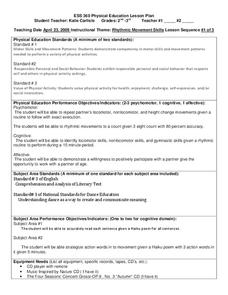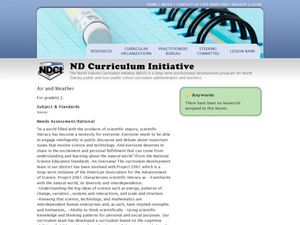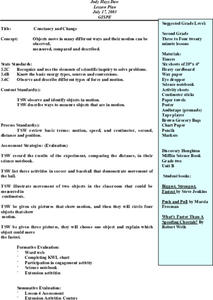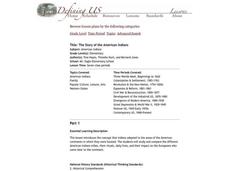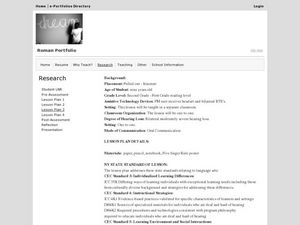Curated OER
Introducing Literary Elements in Fiction
Identify literary elements in fiction. In this reading comprehension lesson, learners read the book Pigsty and record literary elements onto a graphic organizer. They specifically discuss the main characters and events in the text.
Curated OER
Tulips: Repeated Addition
This is an introductory lesson intended to prime young mathematicians for later lessons in multiplication. They watch the video Count on it!, discuss problem solving as a class, then work the presented problem using repeated addition....
Curated OER
Understanding 10: Backwards and Forwards
Help your young mathematicians completely master 10 by practicing one-to-one correspondence, number recognition, and recording numbers displayed. They make 10 with groups of two-different colored cubes and color in 10-frames to show how...
Curated OER
Government
Second graders run for various offices. They dress up like a politician, pretend to be running for an office, and tell the students why they should vote for him/her. They explain why it is necessary for a community to have a government
Curated OER
Rhythmic Movement Skills
Learners explore rhythmic movements. In this performing arts lesson plan, students create their own movements and then repeat the each others movement. Finally, learners create movements to the Haiku generated by the entire class.
Curated OER
Elements for Disaster Reporting
Students identify the elements of natural disasters and gain an understanding on how the media influences people's responses to disasters. In this natural disaster lesson plan, students study the impact of natural disasters, and the...
Curated OER
Plunge Into Place Value
Students use expanded notation. For this mathematics lesson, students determine the place value of a digit within a whole number. Students use manipulatives, words, and symbols to represent whole numbers.
Curated OER
Comic Strip Context Clues
Second graders create dialogue for a comic strip using context clues to match the text to the pictures. They use comic blanks imbedded in this lesson. They write dialogue for each frame. Remind them to use the picture clues when writing...
Curated OER
Children Using Antonyms to Write Short Stories
Second graders discuss what antonyms are and read the book, Quick as a Cricket. In this antonym lesson, 2nd graders write a short story by describing themselves.
Curated OER
Air and Weather
Second graders study Earth's materials. In this air and weather lesson, 2nd graders note changes in the weather and examine tools that help us study the weather. Students analyze how changes in the environment make changes in the...
Curated OER
Coin Carnival
Students investigate the value of coins. In this coin value lesson, students read The Penny Pot by Stuart Murphy. Students expand on skills learned in the book and engage in activities to determine the value of a mixed set of coins while...
Curated OER
Greetings and Introductions
Students recite common forms of courtesy, greetings and leave takings appropriate to the time of day. They practice identiying the differences in forms of address for age and rank. Pupils are each given a copy of the "Greetings and...
Curated OER
Understanding How Potatoes Grow
Second graders make a KWL chart and brainstorm what they need for the project of growing potatoes. They choose one potato and plant it in water or peat moss cups and choose a location in which meets the needs of the plants and make their...
Curated OER
Constancy and Change
Second graders investigate how objects can move in different ways. They move in different ways across the room and develop a class list of movement words. Students also conduct a measuring motion experiment, create a bar graph for the...
Curated OER
American Indians
Students research early Indian adaptations in this lesson. They research the different American Indian tribes. They also research and compare the tribes' rituals, daily lives, and their impact on the Europeans who came later to the...
Curated OER
Welcome to the Class
Students recognize behaviors that make them better citizens. In this group cooperation lesson, students create a class chart of behaviors when the class cooperates. Students role play situations with new students to identify successful...
Curated OER
Creating Comic Strips
Students create comic strips to communicate ideas that cannot be expressed through words alone.
Curated OER
One Good Turn Deserves Another
Students make observations about shapes and 1-, 2-, and 3-dimensional objects. They conduct observations and make predictions regarding transformations of simple geometric shapes. They identify shapes that occur in household items.
Curated OER
The Frog and the Ol' Black Fly
Students explore frogs. For this cross curriculum literacy and frogs lesson, students predict the plot and then listen to the book The Wide-Mouthed Frog by Keith Faulkner. Students define "predator" and identify foods a frog might...
Curated OER
How Do I know That a Book Is Just Right for Me to Read?
Students choose a book for reading. In this language arts instructional activity, students take steps to evaluate a book for free reading. Students make a list of words found in the book that they are unfamiliar with.
Curated OER
Understanding and Stay Interested in Reading
Second graders make predictions about reading. In this remedial reading lesson, 2nd graders read a favorite author's story, and read about an animal or favorite hobby or how-to. Students discuss the various purposes for...
Curated OER
LOOKING AT A CHARACTER
Second graders investigate self- and teacher-selected literature (e.g., picture books, nursery rhymes, fairy tales, poems, legends) from a variety of cultures. They re-enact and retell stories, songs, poems, plays, and other literary...
Curated OER
Scrapbook of Evidence
Students read three different genres of fiction. They create a story map and brainstorm possible collage inclusions. Each student prepares a minimum of two scrapbook page entries for each text or passage. Students write beside each...
Curated OER
Family Names
Young scholars draw a family tree. They label familiar items (e.g., family members, classroom objects, and pets). Pupils are given a copy of the worksheet "Family Name," they draw a family tree, label themselves and at least 10...




